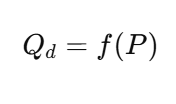Demand, supply, and market equilibrium are the fundamental concepts of economics explaining the interaction between buyers and sellers in any market. These principles determine how goods and services are allocated, priced, and traded within an economy. Understanding the dynamics of demand, supply, and market equilibrium helps to explain fluctuations in prices and quantities of goods and how the market “balances” itself over time. It goes deep into those concepts and explains, step-by-step, how each of them functions individually as well as together in determining the conditions in any given market.
Demand & Law of Demand
Demand is the quantity of a good or service that people are willing and able to buy at various prices in any given period. All else held constant, a decrease in the price of any good or service leads to an increase in its quantity demanded. Conversely, an increase in the price causes a reduction in the quantity demanded.
Law of Demand
The law of demand is a simple principle that describes the negative correlation between the price and quantity demanded of a good or service. Essentially, the reasoning behind this law is such that when the price reduces, consumers tend to buy more as they get more value out of the same money, while rising prices reduce purchasing power for consumers, leading to demand reduction.
The law of demand can be expressed mathematically as:

Where:
- Qd= Quantity demanded
- P = Price
- The function f(P)f(P) indicates that the quantity demanded is a function of the price.
Exceptions to the Law of Demand
There are some exceptions to the law of demand, where higher prices may lead to higher demand:
- Giffen Goods: Some inferior goods, like the staple foods of the deprived, will respond to a rise in price by increasing in demand because there is no acceptable substitute.
- Veblen Goods: The luxury goods with higher prices and, in that way, more attractive, because they signal status or prestige.
In general, however, the law of demand holds in most typical market situations.
What Factors Change Demand?
Demand for a good or service can shift due to several factors. Hence, the demand curve shifts either to the right when demand increases or to the left when demand decreases. Some of these factors include consumer preferences, income, prices of related goods, expectations, and demographic changes. These shifts in demand have significant implications for businesses and policymakers.
Determinants of Demand
- Consumer Income: The increase in consumers’ incomes often leads to an increase in demand for goods and services, provided the good is a normal good. For inferior goods, higher income may lead to decreased demand.
- Consumer Preferences: Changes in tastes and preferences may have a drastic effect on demand. For example, if a particular good becomes fashionable, then demand increases. The popularity of a product often leads to increased consumer interest, even if the price of the product remains the same.
- Prices of Related Goods: The prices of substitute and complementary goods also affect demand. For example, if the price of a substitute good such as butter falls, the demand for the original good such as margarine may decline. On the other hand, a decrease in the price of a complementary good such as printers for computers may increase the demand for the primary good, which is computers.
- Expectations of Future Prices: If consumers expect prices to rise in the future, they may decide to purchase more of the goods today, increasing current demand. On the other hand, if prices are expected to fall, they might wait for the price drop, decreasing current demand.
- Demographic Changes: A population can also shift demand by a rise in population or the age structure. An aging population may require health care services more.
- Seasonal Factors: There are some products whose demand follows seasons. Demand for winter wear increases as the season of cold begins, and during hot summer seasons, people demand air conditioners more.
Shifting of Demand Curve
When any of these factors change, it causes a shift in the entire demand curve. A right-ward shift indicates an increase in demand and vice versa because a left-ward shift indicates a decrease in demand. This is important because shifts allow us to study how markets respond to shifts in the external conditions surrounding them.
Law of Supply
The law of supply is such that, all things held constant, as the price of a good or service rises, the quantity supplied increases. Conversely, as the price of a good falls, the quantity supplied decreases. This is because high prices encourage producers to supply more of a good to the market as they may make more profits.
Characteristics of the Supply Curve
The supply curve normally slopes upwards from left to right. There is a positive relationship between price and quantity supplied. When prices are high, producers are more willing and able to supply more goods. Low prices tend to discourage producers from supplying goods, thus reducing the quantity supplied.
The law of supply can also be expressed mathematically as:

Where:
- Qs = Quantity supplied
- P = Price
- The function g(P)g(P) shows that the quantity supplied increases with the price.
Factors Affecting Supply
Several factors influence the supply of a good, and understanding these can help predict how changes in the market will affect the availability and pricing of goods.
Factors That Affect the Quantity Supplied
- Price: Price is the quantity supplied’s major determinant. The higher the price level, the more profitable the production and selling of goods is, so it increases the quantity supplied. On the other hand, lower price levels reduce incentives to supply the good.
- Cost of Inputs: An increase in the cost of inputs, labor, raw materials, or energy may reduce the profitability of producing a good. This may then lead to the supply being reduced, meaning that the supply curve would shift left.
- Technological Gains: Technology can make a production process more efficient while reducing cost and enabling a greater supply of goods at any existing price. Technological factors often cause the supply curve to shift to the right.
- Government Actions: There are a variety of possible government interventions in supply through regulations, taxes, and subsidies. A subsidy placed on goodwill induces an increase in supply from all producers, whereas taxes payable on producing will deter such supply.
Change in Supply vs Change in Quantity Supplied
It is important to distinguish between a change in supply and a change in quantity supplied, as they have different causes and effects.
Change in Supply
A change in supply refers to a shift in the entire supply curve. This can be due to various factors, such as changes in production costs, technological progress, or government policies. Whenever the supply curve shifts, it reflects a change in the quantity of goods that producers are willing to supply at every price level.
Change in Quantity Supplied
The movement along the supply curve is called a change in quantity supplied when it occurs due to a change in price. If the price of a good increases, then the quantity supplied will increase. If the price of a good falls, then the quantity supplied will fall. It is in the same supply curve but not shifting the curve.
Market Equilibrium
Market equilibrium represents a state in which the consumers’ quantity demanded is equal to the quantity supplied by producers. Here, there exists neither excess supply nor excess demand, and at this equilibrium price, the market “clears”.
Characteristics of Market Equilibrium
The forces of demand and supply are in balance at equilibrium, and the price at which equilibrium occurs is called the equilibrium price, while the corresponding quantity of goods bought or sold at this price is called the equilibrium quantity.
- Equilibrium Price: The price at which the quantity demanded equals the quantity supplied.
- Equilibrium Quantity: The amount of the good that is bought and sold at the equilibrium price.
The market always adjusts to move towards equilibrium. Even in the face of disruptions, the market always tends to move towards equilibrium. If there is surplus-excess supply, the price will fall, and if there is shortage-excess demand, the price will increase. Through this adjustment, the market reaches equilibrium.
Changes in Market Equilibrium
Market equilibrium can shift if a shift occurs in the demand curve or the supply curve. A change in demand or supply shifts the new equilibrium price and quantity.
- Impacts of Demand Change: If demand increases (shifts to the right) then the equilibrium price will be positive as will be the new equilibrium quantity. Conversely, if demand decreases shifts to the left both equilibrium price and quantity falls.
- Effects of an Increase in Supply: An increase in supply (to the right) lowers the equilibrium price and increases the equilibrium quantity. A decrease in supply (to the left) raises the equilibrium price, and the equilibrium quantity falls.
Changes in Equilibrium Price and Quantity When Demand and Supply Change
Both demand and supply can change simultaneously, and these changes can affect the equilibrium price and quantity in different ways.
- Rise in Both Demand and Supply: When both demand and supply rise, the equilibrium quantity increases, but the change in price depends upon the relative magnitude of the shifts. If demand rises more than supply. Then the price rises; if supply rises more than demand, the price falls.
- Both demand and supply are decreased: Equilibrium quantity falls, but the price might either increase or fall based on which curve has moved more. A larger movement in demand results in a lower equilibrium price, whereas a bigger movement in supply will drive prices up.
Demand Supply and Market Equilibrium FAQs
What is the difference between a change in demand and a change in quantity demanded?
A change in demand refers to a shift in the entire demand curve, influenced by factors like consumer income or preferences. A change in quantity demanded refers to a movement along the same demand curve due to a price change.
How do technological advancements affect supply?
Technological advancements lower production costs, making it more profitable to supply goods. As a result, the supply curve shifts to the right, increasing the quantity supplied at every price.
What happens when both demand and supply increase?
When both demand and supply increase, the equilibrium quantity will rise. The effect on price depends on the magnitude of the shifts; if demand increases more than supply, the price will rise, but if supply increases more than demand, the price may fall.
What is market equilibrium?
Market equilibrium occurs when the quantity demanded by consumers equals the quantity supplied by producers. This results in a stable price and quantity in the market.
How does government intervention affect market equilibrium?
Government interventions, such as taxes or subsidies, can shift the supply or demand curve. A tax typically reduces supply, leading to higher prices, while a subsidy can increase supply, lowering prices.


